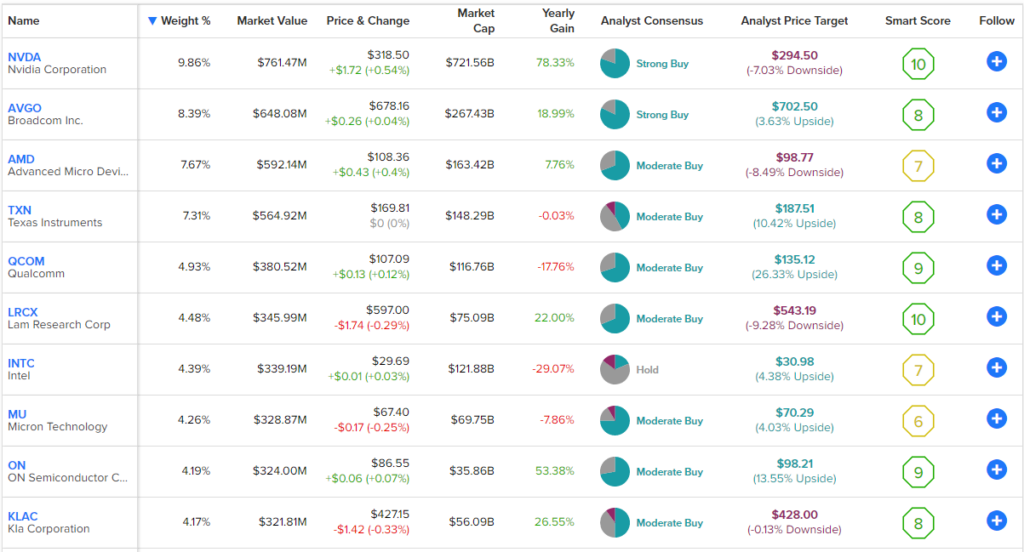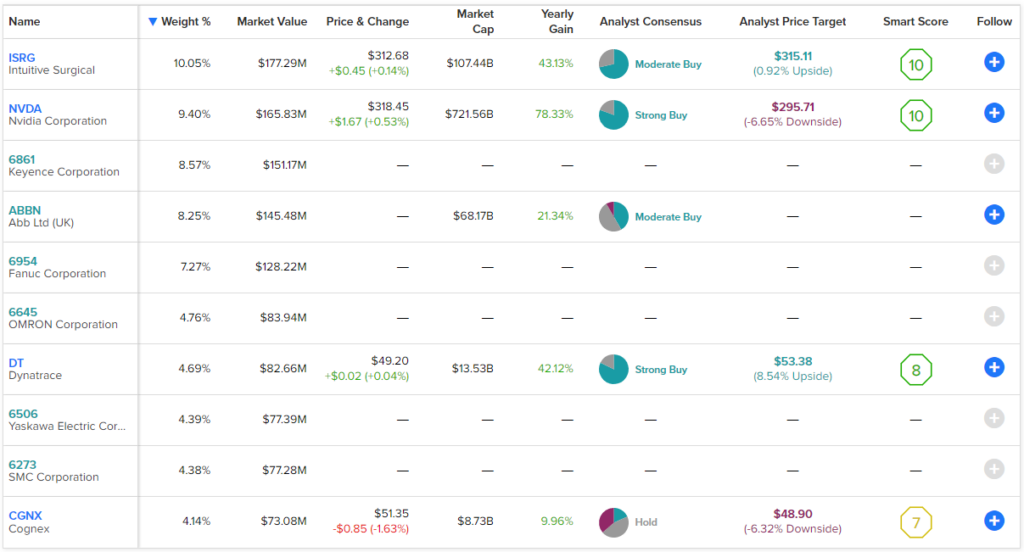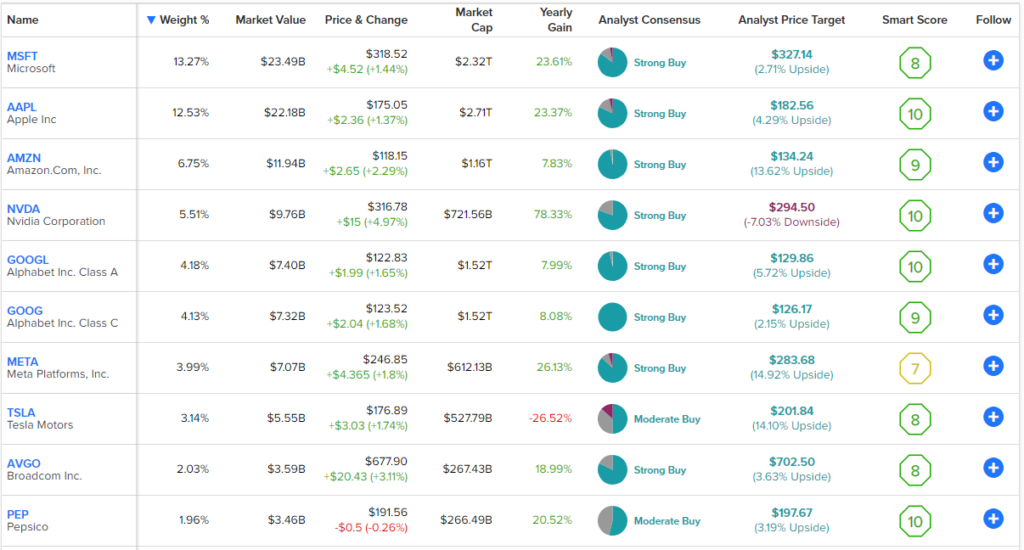Perhaps no stock has captured the market’s imagination this year more than semiconductor giant Nvidia (NASDAQ:NVDA). After a challenging 2022, the stock that many perceive as the leader in artificial intelligence (AI) technology is off to a gain of over 120% so far this year, and it’s only May.
Meet Your ETF AI Analyst
- Discover how TipRanks' ETF AI Analyst can help you make smarter investment decisions
- Explore ETFs TipRanks' users love and see what insights the ETF AI Analyst reveals about the ones you follow.
As the world’s sixth-largest company by market cap, Nvidia is owned by many ETFs, particularly AI, tech, and semiconductor-focused ones, and these ETFs have also performed well.
This article will highlight five ETFs that have large positions in Nvidia, and these could be solid options for investors looking to gain exposure to the stock using ETFs. The upside of investing through an ETF is that investors can also gain exposure to Nvidia’s peers and competitors that offer exposure to the same themes, like the rise of AI and the long-term growth of semiconductor demand.
Superinvestors are Flocking to Nvidia
Before delving into the ETFs, let’s take a brief look at the rise of Nvidia itself. The stock boasts an enviable Smart Score of 9 out of 10. The Smart Score is TipRanks’ proprietary quantitative stock scoring system that evaluates stocks on eight different market factors. The result is data-driven and does not require any human intervention. A Smart Score of 8 or above is the equivalent of an Outperform rating.
Nvidia has surged this year on the back of excitement about its AI opportunity, but that hasn’t stopped some of the world’s top investors from piling in. According to recent filings, David Tepper of Appaloosa Management, Lee Ainslie’s Maverick Capital, and Chase Coleman’s Tiger Global all initiated new positions in Nvidia during the first quarter of 2023.
Stanley Druckenmiller, who reportedly generated annual returns of 30% for his investors for many years at Duquesne Capital and famously helped George Soros “break” the Bank of England by shorting the pound, also started a position in the company.
Druckenmiller’s involvement is interesting because he is currently less enthusiastic about the market in general. The legendary hedge fund manager believes we are in for a “hard landing.” Therefore, you would likely expect an investor like Druckenmiller to avoid a name like Nvidia that trades at over 60 times forward earnings, but Druckenmiller apparently isn’t dissuaded by Nvidia’s steep valuation multiple or the possibility of a looming recession.
Druckenmiller’s family office bought shares of AI leaders like Nvidia and Microsoft (NASDAQ:MSFT) during the first quarter, putting $220 million into Nvidia. In a recent discussion at the Sohn Conference, he said that he thinks AI is “very real” and that “it could be as impactful as the internet.” He also said that these stocks will present great opportunities coming out of a hard landing. Druckenmiller says that even in the event of a recession, he doesn’t think Nvidia’s stock price will necessarily go down, even given the high valuation multiple.
These top investors appear unfazed by Nvidia’s valuation and its strong year-to-date performance. Therefore, here are five different ways to invest in Nvidia using ETFs.
1. iShares Semiconductor ETF (NASDAQ:SOXX)
One simple and effective way to invest in Nvidia is through the SOXX ETF from iShares. Nvidia is the 800-pound gorilla in the chip space right now, so it is the top holding for this chip-focused ETF, with a weighting of 9.9%. Check out an overview of SOXX’s top 10 holdings below, using TipRanks’ Holdings tool.

A benefit of investing in SOXX is that in addition to this exposure to Nvidia, you also get plenty of exposure to Nvidia’s competitor, Advanced Micro Devices (NASDAQ:AMD), which is making its own inroads into AI.
SOXX has a reasonable expense ratio of 0.35%, and it has been a strong performer in recent years, outperforming the S&P 500 and the Nasdaq 100 with an annualized return of 30.7% over the past three years (as of the end of the first quarter).
SOXX has a weighted average P/E ratio of 20.1, meaning that it trades at a slight discount to the broader market (which trades at around 24x earnings). Note that SOXX also has a strong ETF Smart Score of 8 out of 10. With low fees, a reasonable valuation, a strong performance track record, and a large position in Nvidia, SOXX looks like an ideal choice for ETF investors who want to invest in Nvidia.
2. VanEck Semiconductor ETF (NASDAQ:SMH)
Staying in the world of major semiconductor ETFs, VanEck’s $7.5 billion SMH ETF also has Nvidia as its largest holding. In fact, it has even more exposure to Nvidia than SOXX does, with a 15.1% weighting. You can gain an overview of SMH’s top 10 holdings using the chart below.

As is the case with SOXX, SMH also gives you plenty of exposure to AMD as well as to semiconductor fabricators like Taiwan Semiconductor (NYSE:TSM) and equipment maker Lam Research (NASDAQ:LRCX), which are crucial semiconductor companies.
SMH has the exact same expense ratio as SOXX (0.35%), and that’s likely no accident, as they are competing for the same types of investment dollars. SMH’s weighted average P/E ratio is a bit higher than SOXX’s at 22.8, and while its three-year return of 23.7% lags SOXX’s spectacular 30.9% return over the same time frame, this is still an excellent return.
With a similarly modest fee, solid track record, reasonable valuation, and large weighting towards Nvidia, SMH looks like another great choice for investors looking for Nvidia exposure.
3. Global X Robotics & Artificial Intelligence ETF (NASDAQ:BOTZ)
While SOXX makes Nvidia its top holding due to its semiconductor investment universe, BOTZ is an AI-focused ETF from Global X that features Nvidia as its second-largest holding, with a 9.4% weighting. Nvidia trails only Intuitive Surgical (NASDAQ:ISRG), which has a 10.05% weighting. See below for an overview of BOTZ’s top holdings.

In addition to Nvidia and Intuitive Surgical, BOTZ owns quite a few international stocks that are involved in AI, robotics, and automation that may not be familiar to most investors.
BOTZ is off to a nice 25.2% year-to-date gain. However, its three-year annualized return of 6.6% and its five-year annualized return of 2.0% lag those of SOXX, SMH, and the broader market. BOTZ also has an expense ratio that is nearly twice as high as SOXX’s, at 0.69%. Lastly, BOTZ’s weighted average P/E ratio is higher than SOXX’s or SMH’s at 38.7 times earnings.
BOTZ stock has performed well this year, and it gives investors undiluted exposure to a lot of under-the-radar AI names. However, based on the aforementioned factors, SOXX and SMH appear to be better choices when it comes to Nvidia-related ETFs.
4. Technology Select Sector SPDR Fund (NYSEARCA:XLK)
Thanks to the fact that Nvidia’s climb has made it one of the world’s largest and most valuable companies, you don’t really have to get too fancy to invest in it using ETFs. This large, tech-centric ETF from State Street with $43.6 billion in assets under management (AUM) is broader in its focus than SOXX or BOTZ, but it still features Nvidia fairly heavily. Nvidia is XLK’s third-largest holding, with a weighting of 4.7%. You’ll find an overview of XLK’s top holdings below.

One thing to note is that while Nvidia is the third-largest position in XLK, it’s dwarfed by the likes of Microsoft and Apple (NASDAQ:AAPL), which have much larger weightings.
XLK has a very favorable expense ratio of just 0.10%. It also has a rock-solid performance track record, providing investors with annualized total returns of 19.2% over the past three years, 19.5% over the past five years, and 18.9% over the past decade (as of the end of the most recent quarter).
While XLK doesn’t have the largest Nvidia weighting on this list, it’s likely a good way to get exposure to the tech sector as a whole, and it’s hard to argue with its long track record of performance.
5. Invesco QQQ Trust (NASDAQ:QQQ)
Last but not least, QQQ is a massive ETF with nearly $175 billion in AUM that invests in the Nasdaq 100. Because Nvidia is a major component of the Nasdaq 100, QQQ has a sizable Nvidia position of 5.5%.

QQQ is similar to XLK in that it holds larger positions in Microsoft and Apple, although they don’t dominate the fund to quite the same extent as they do in XLK, with weightings of 13.3% and 12.5%, respectively.
In the table above, you’ll notice that QQQ’s top holdings have strong Smart Scores — nine of the top 10 holdings have Smart Scores of 8 or better.
If you are interested in Nvidia for the AI angle, QQQ should appeal to you, as it also holds large positions in other AI leaders like Microsoft, Alphabet (NASDAQ:GOOG) (NASDAQ:GOOGL) and Meta Platforms (NASDAQ:META).
QQQ offers a modest expense ratio of 0.2%, and it has provided its investors with great returns over the years, posting annualized returns of 19.8% over the past three years, 15.7% over the past five, and 17.7% over the past 10.
For investors looking for Nvidia and a host of other AI leaders, this looks like a solid choice to go with.
Investor Takeaway
Nvidia has captured the attention of retail investors and renowned hedge fund managers alike, taking the market by storm with a gain of over 120% in 2023 so far.
For ETF investors interested in gaining exposure to this powerhouse, the five ETFs above offer different avenues for doing this. Of the five, my top choices would be SOXX or SMH. This is because of their large positions in Nvidia and the fact that Nvidia isn’t overshadowed by much larger positions in Microsoft or Apple, as is the case with XLK and, to a lesser extent, QQQ.
I also like SOXX’s and SMH’s performance track record, modest fees, valuations, and exposure to other semiconductor companies that could play a role in the AI revolution. SOXX has a slight edge over SMH in most of these categories, making it the winner by a narrow margin, but at the end of the day, both appear to be solid choices for investors looking to add Nvidia to their portfolios.
While SOXX looks like the top choice, XLK or QQQ are attractive based on their broad exposure to tech and other AI leaders in addition to Nvidia, their low fees, and their proven long-term track records. Of the two, I give a slight edge to QQQ just because it isn’t as beholden to just two names (Microsoft and Apple) as XLK is.
BOTZ is not a bad ETF, and it holds a host of interesting AI-related names that are hard to find elsewhere, but given its higher fees and less impressive long-term track record (compared to the other names), this would be my last pick of the five ETFs discussed here.
















